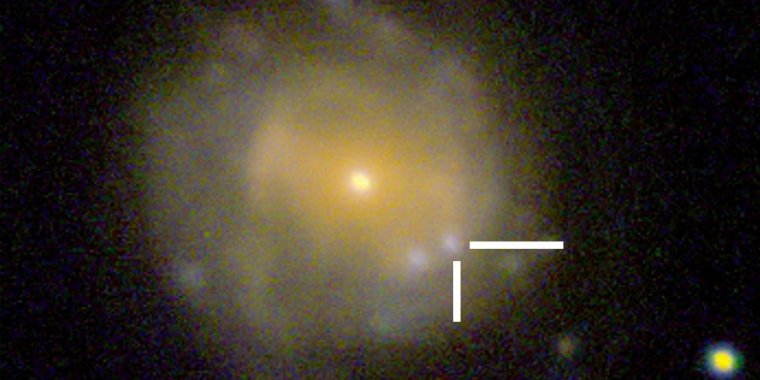| News / Space News |
Mysterious Blast Studied with NASA Telescopes
A brief and unusual flash spotted in the night sky on June 16, 2018, puzzled astronomers and astrophysicists across the globe. The event - called AT2018cow and nicknamed "the Cow" after the coincidental final letters in its official name - is unlike any celestial outburst ever seen before, prompting multiple theories about its source.

AT2018cow erupted in or near a galaxy known as CGCG 137-068, which is located about 200 million light-years away in the constellation Hercules. This zoomed-in image shows the location of the "Cow" in the galaxy. Credit: Sloan Digital Sky Survey
Over three days, the Cow produced a sudden explosion of light at least 10 times brighter than a typical supernova, and then it faded over the next few months.
This unusual event occurred inside or near a star-forming galaxy known as CGCG 137-068, located about 200 million light-years away in the constellation Hercules. The Cow was first observed by the NASA-funded Asteroid Terrestrial-impact Last Alert System telescope in Hawaii.
One potential explanation of the Cow is that a star has been ripped apart in what astronomers call a "tidal disruption event." Just as the Moon's gravity causes Earth's oceans to bulge, creating tides, a black hole has a similar but more powerful effect on an approaching star, ultimately breaking it apart into a stream of gas.
The tail of the gas stream is flung out of the system, but the leading edge swings back around the black hole, collides with itself and creates an elliptical cloud of material.
According to one research team using data spanning from infrared radiation to gamma rays from Swift and other observatories, this transformation best explains the Cow's behavior.
Researchers think the shredded star was a white dwarf - a hot, roughly Earth-sized stellar remnant marking the final state of stars like our Sun. They also calculated that the black hole's mass ranges from 100,000 to 1 million times the Sun's, almost as large as the central black hole of its host galaxy.
It's unusual to see black holes of this scale outside the center of a galaxy, but it's possible the Cow occurred in a nearby satellite galaxy or a globular star cluster whose older stellar populations could have a higher proportion of white dwarfs than average galaxies.
A different team of scientists was able to gather data on the Cow over an even broader range of wavelengths, spanning from radio waves to gamma rays. Based on those observations, the team suggests that a supernova could be the source of the Cow.
When a massive star dies, it explodes as a supernova and leaves behind either a black hole or an incredibly dense object called a neutron star. The Cow could represent the birth of one of these stellar remnants. (NASA)
YOU MAY ALSO LIKE



